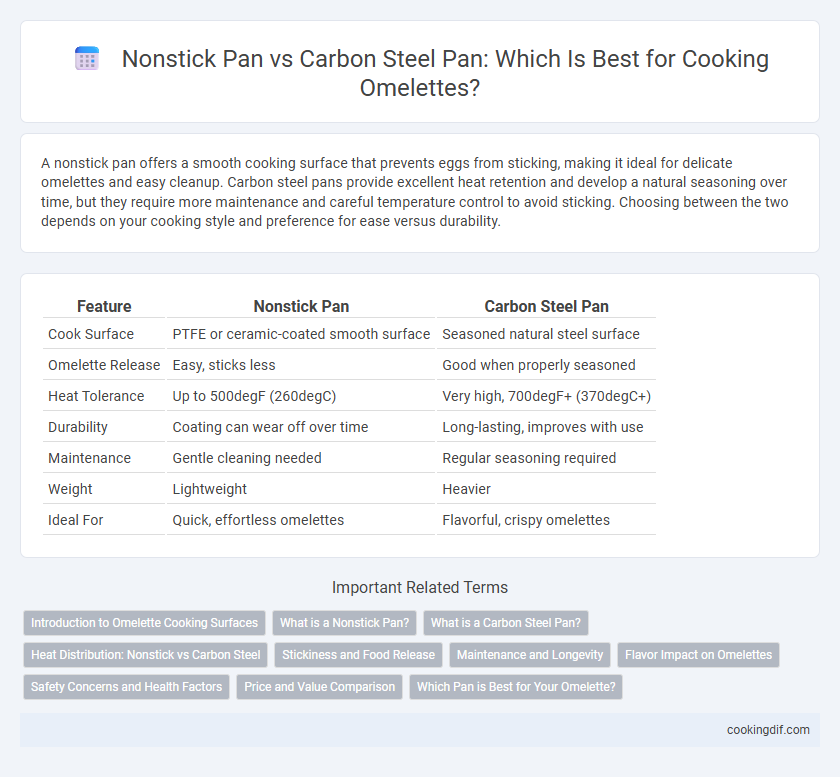A nonstick pan offers a smooth cooking surface that prevents eggs from sticking, making it ideal for delicate omelettes and easy cleanup. Carbon steel pans provide excellent heat retention and develop a natural seasoning over time, but they require more maintenance and careful temperature control to avoid sticking. Choosing between the two depends on your cooking style and preference for ease versus durability.
Table of Comparison
| Feature | Nonstick Pan | Carbon Steel Pan |
|---|---|---|
| Cook Surface | PTFE or ceramic-coated smooth surface | Seasoned natural steel surface |
| Omelette Release | Easy, sticks less | Good when properly seasoned |
| Heat Tolerance | Up to 500degF (260degC) | Very high, 700degF+ (370degC+) |
| Durability | Coating can wear off over time | Long-lasting, improves with use |
| Maintenance | Gentle cleaning needed | Regular seasoning required |
| Weight | Lightweight | Heavier |
| Ideal For | Quick, effortless omelettes | Flavorful, crispy omelettes |
Introduction to Omelette Cooking Surfaces
Nonstick pans offer a smooth cooking surface that prevents eggs from sticking, making them ideal for delicate omelettes requiring easy folding and flipping. Carbon steel pans develop a natural seasoning layer over time, providing excellent heat retention and a slightly textured surface that enhances browning and flavor complexity. Both surfaces demand different care and seasoning routines, influencing omelette texture and cooking experience.
What is a Nonstick Pan?
A nonstick pan features a smooth coating, typically made from polytetrafluoroethylene (PTFE) or ceramic, designed to prevent food from sticking during cooking, making it ideal for delicate dishes like omelettes. This pan allows for cooking with less oil, ensuring a gentle heat distribution that helps achieve a tender, evenly cooked omelette without tearing. Nonstick pans offer easy food release and quick cleanup, enhancing the overall cooking experience for egg-based recipes.
What is a Carbon Steel Pan?
A carbon steel pan is a versatile cooking tool made from a blend of iron and carbon, prized for its superior heat conductivity and durability compared to nonstick pans. Unlike nonstick surfaces that rely on synthetic coatings, carbon steel pans develop a natural seasoning that enhances their nonstick properties over time, allowing for better browning and flavor development in omelettes. This pan type heats evenly and withstands higher temperatures, making it ideal for achieving the perfect golden crust without the risk of damaging the cooking surface.
Heat Distribution: Nonstick vs Carbon Steel
Nonstick pans provide even heat distribution with a smooth surface that prevents omelettes from sticking, allowing for gentle, consistent cooking. Carbon steel pans excel at heat retention and develop natural seasoning over time, offering superior heat responsiveness and the ability to achieve a perfectly golden crust. Choosing between them depends on whether precision nonstick performance or high-heat searing and durability is prioritized in omelette preparation.
Stickiness and Food Release
Nonstick pans excel in preventing omelette stickiness due to their smooth, coated surface that ensures easy food release with minimal oil. Carbon steel pans offer superior heat retention and can develop a natural nonstick patina over time but require proper seasoning and maintenance to prevent sticking. For consistently smooth omelette cooking and effortless release, nonstick pans are generally more reliable, while carbon steel demands skill for optimal performance.
Maintenance and Longevity
Nonstick pans require gentle cleaning with soft sponges and avoid abrasive materials to maintain their coating, resulting in a shorter lifespan of 3 to 5 years. Carbon steel pans develop a natural nonstick surface through seasoning, allowing for more durable use and can last decades with proper maintenance, including thorough drying and occasional oiling to prevent rust. The longevity of carbon steel far exceeds nonstick pans when regularly maintained, making it a cost-effective option for frequent omelette cooking.
Flavor Impact on Omelettes
Nonstick pans provide a smooth cooking surface that prevents omelettes from sticking, ensuring a delicate texture and preserving subtle egg flavors. Carbon steel pans develop a natural seasoning over time, which can add a rich, slightly smoky taste to the omelette, enhancing its overall flavor complexity. While nonstick pans offer ease and consistency, carbon steel pans deliver a more pronounced and nuanced flavor profile due to their unique seasoning properties.
Safety Concerns and Health Factors
Nonstick pans, typically coated with polytetrafluoroethylene (PTFE), raise safety concerns when overheated above 500degF, potentially releasing toxic fumes harmful to respiratory health. Carbon steel pans, made from natural iron-carbon alloy, pose fewer health risks since they lack synthetic coatings and can develop a natural nonstick surface with seasoning, although improper maintenance may lead to rust and contamination. Choosing between these pans involves balancing the chemical exposure risks of nonstick coatings against the durability and seasoning-dependent safety of carbon steel surfaces.
Price and Value Comparison
Nonstick pans typically cost between $20 and $70, offering excellent value for effortless omelette flipping and easy cleanup due to their smooth, coated surfaces. Carbon steel pans range from $25 to $100, providing superior heat retention and durability but require regular seasoning and maintenance to prevent sticking. Considering price and performance, nonstick pans deliver better affordability and convenience for beginners, while carbon steel offers long-term value for those skilled in managing cooking surfaces.
Which Pan is Best for Your Omelette?
Nonstick pans provide an even, smooth cooking surface that prevents omelettes from sticking and ensures easy flipping, making them ideal for delicate eggs. Carbon steel pans offer superior heat retention and develop a natural seasoning over time, which can enhance flavor and create a slightly crispier omelette texture. Choosing between the two depends on your preference for ease of use and maintenance versus a more traditional, flavorful cooking experience.
Nonstick Pan vs Carbon Steel Pan for cook surface Infographic

 cookingdif.com
cookingdif.com